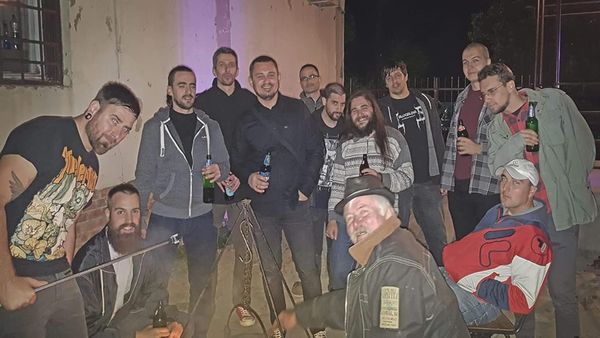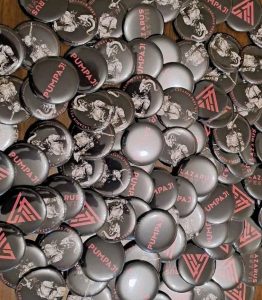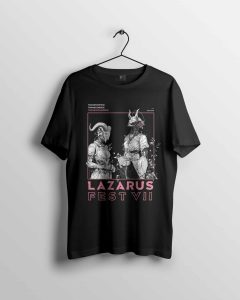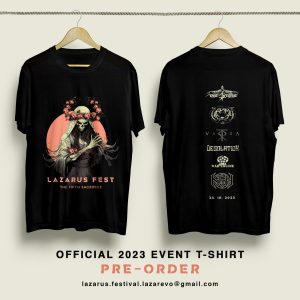Lazarus Fest is an alternative underground music festival held in the village of Lazarevo near Zrenjanin. It was founded in 2018 and immediately became the most successful project of the citizens’ association RNR Zona Lazarevo. It traditionally takes place in the second half of October at the Lazarevo Cultural Center.
2012 – 2016
The early phase of the RNR Zona Lazarevo association, from its founding in 2012, was marked by organizing small concerts, mostly by cover bands, several times a year. These took place in the Cultural Center or the premises of the Pensioners’ Association, continuing the long tradition of rock concerts in Lazarevo. The central event of each concert season was Gitarijada, which was held every September until 2017, when it was organized for the last time under that name.
2017
The year 2017 brought major turmoil within the association, with leadership changes and conflicting visions of the future. Two opposing concepts emerged: one group envisioned the association’s future in motorcycle gatherings, while the other supported developing a modern festival of regional and international significance, in line with contemporary rock music trends. These changes were accompanied by an influx of younger members and the departure of older ones, completing a generational shift by the end of the year. During this time, several concerts were organized, including the final Gitarijada.
The turning point came in October 2017, when the association decided to fully dedicate itself to concerts featuring young, non-established, original, underground performers. The first step in this direction was a concert at the premises of the Pensioners’ Association in Lazarevo on October 14, with performances by Lednik (Novi Sad), Nous Thaw (Ruma) and Cheap Moonshine (Novi Sad). This event planted the seed of the festival idea and is considered the “zero” Lazarus.
2018
The project named Lazarus Fest received official support from the Zrenjanin city government and the Lazarevo local office in the form of co-financing, taking the place of the former Gitarijada. Several concerts preceded the festival that year: Madresi (January 1), Forgotten Scream (March 17), and the legendary Instant Karma (July 28). All of these confirmed the association’s complete shift toward original acts.
The first edition of Lazarus Fest, held on October 20, focused on “conquering” the Zrenjanin audience and drawing attention to the festival’s existence. Some of the most important Zrenjanin underground bands performed: Drink or Die, Trash Union, Desolation, with special guests Counter Ignition from Kovin. With around 100 visitors, this pilot project exceeded all expectations and became the association’s most successful and best-attended event up to that point.
2019
The success of the first edition led the association to abandon solo concerts and direct all resources toward Lazarus Fest. If the first year’s goal was to win over the Zrenjanin audience, the second aimed to capture the attention of the entire Serbian alternative and underground scene. To achieve this, the lineup included some of the most notable names of the new Serbian alternative scene: Brigand (Pančevo), Nemesis (Beograd), Quasarborn (Beograd), Mud Factory (Vranje), Nula (Beograd). Local acts Empathy Soul Project and Forgotten Scream also performed.
Held on October 19, with about 150 visitors, the second edition surpassed the first in attendance and was widely covered by nearly all relevant media portals dedicated to Serbia’s underground and alternative scene. Lazarus Fest thus firmly established itself on the underground map as an event that transcends local boundaries. Once again, it was supported by municipal and city funds, as well as local sponsors.
2020
Due to the COVID-19 pandemic, the third edition of the festival was postponed to the following year.
2021
The third edition, held on October 23, highlighted the so-called “Banat hardcore”, with its unique aesthetic, ethos, and poetics. Bands that shaped and modernized that sound performed – Downstroy (Kikinda), Desolation (Zrenjanin), Forgotten Scream (Zrenjanin). New local acts also appeared, such as Direct Drive, with their grunge-inspired sound (which later won them recognition at the Gitarijada Zaječar) and Affliction, one of the youngest Serbian bands at that time. The legendary Bombarder, pioneers of Yugoslav speed/thrash metal with a cult status both regionally and internationally, performed as the headliners.
This lineup created unprecedented generational synergy and drew around 200 visitors to Lazarevo’s Cultural Center. Beyond attendance, the festival was praised for its organizational quality, especially in terms of sound engineering and lighting.
2022
The fourth edition marked the festival’s first steps toward internationalization, as well as stylistic eclecticism. International acts included Torn From Earth (post-metal / doom / sludge from Budapest) and Defiant (black / death metal from Croatia). Domestic diversity came from Lednik (instrumental post-metal / post-rock from Novi Sad), Sides (djent from Belgrade), Violent Chapter (pioneers of Serbian modern hardcore / metalcore), and Jenner (all-female heavy / thrash metal trio from Belgrade).
With Jenner, the festival continued its policy of positive discrimination and support for female bands, initiated by Nemesis in the second edition, as well as its promotion of the youngest bands, continued here with Restore after Affliction’s appearance in 2021.
Attendance rose to around 250 visitors.
2023
The fifth anniversary edition of Lazarus Fest brought some of the most representative underground bands with decades of presence on the scene, bands responsible for the very existence and relevance of Serbian underground music in Europe and worldwide. The announcement that cult black metal band The Stone would headline created a strong buzz, joined by the legendary crossover thrash act Nadimač.
This edition also explored whether Balkan traditional heritage, combined with other folk traditions and modern/alternative currents, can become relevant both domestically and globally, through the performance of Belgrade’s ethno band Vartra. It also raised the question of whether youth can bring fresh energy to long-established genres, through the Belgrade thrash metal band Kobold. Finally, it revisited whether Zrenjanin’s hardcore scene, which had its peak in the late 1990s and early 2000s, still has something valuable to offer through the return of Desolation.
Attendance was doubled compared to the previous edition (around 500 visitors), which definitively confirmed the festival’s respectable status within the regional underground scene. That year, for the first time, a masquerade ball was organized for visitors as part of the festival, with a prize awarded for the best costume. Since then, it has become a festival tradition. Also, that year the festival received support for the first time from the Tourist Organization of the City of Zrenjanin, which assisted in providing organized transportation from Zrenjanin to the festival venue in Lazarevo.
2024
As the festival grew, support from the city administration steadily declined year after year, and that year it was completely absent. For the first time, the festival became almost entirely DIY, with the exception of support from the Tourist Organization of the City of Zrenjanin in the form of organized transportation for visitors.
That same year, the organization reached an agreement with Dark Studio for the first time, which elevated the festival to an even higher and more professional level in terms of sound and lighting.
As for the program, the festival ventured further into darker and more sinister territories of the underground. That year featured The Bloody Earth, the legendary funeral doom band from Niš and pioneers of that sound in Serbia; Belgrade’s Svartgren, one of the most respected black metal bands in the region; Oathbringer, guardians of the traditional heavy metal sound from Kragujevac; Mogila Deathcult from Požarevac, catering to death metal connoisseurs; Cheap Moonshine, a stoner doom trio from Novi Sad; and Forgotten Scream once again as the local support act. As secret guests, the festival was closed by Worm Man, an electro duo from Opovo.
Also, for the first time, artists from other fields took the opportunity to further enrich the festival spirit with their exhibitions and art installations, some of which became part of the festival’s permanent installation.
Later that year, Lazarus Fest became the first festival to publicly support the student and civic protests sparked by the collapse of the canopy at the Novi Sad railway station on November 1 of that year, when 16 people lost their lives due to government corruption.





